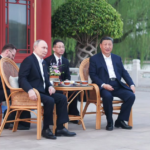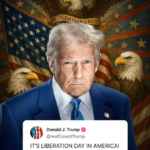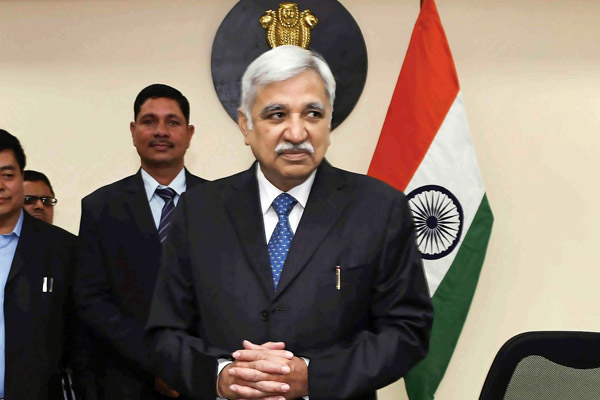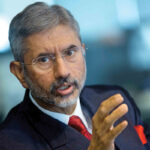In a well-functioning democracy, the righteousness and integrity of bureaucrats and constitutional authorities lend rigidity to the steel frame that is supposed to act as the bulwark in safeguarding the letter and spirit of the constitution. But when those entrusted with the onerous task of upholding the values enshrined in the constitution bend to the will of the politicians or those in power, the famed steel frame begins to crumble.
The Election Commission of India is entrusted to uphold the most sacred tenet of a democracy: elections. As the dust settles on the 2019 General Elections, it’s important to critically scrutinise the conduct of the Chief Election Commissioner, Sunil Arora, who presided over the most virulent elections in independent India.
It was clear from the onset that the 2019 election would be unlike any other. Long before the election dates were announced there were hardly any doubts that the ruling BJP with access to unlimited amounts of money and manpower would be dictating the narrative by means foul or fair. In this scenario, it was even more pertinent that the CEC remained extra vigilant and performed the duties entrusted to him with greater diligence and exercised the powers vested in him under Article 324 of the Indian Constitution without fear or favour. Unfortunately, Arora’s conduct during the drawn-out seven-phase election raised plenty questions for which answers are yet to be found.
Prior to his appointment as the CEC, the 1980-batch Rajasthan cadre IAS officer is best remembered for turning around a bleeding Indian Airlines into a profitable operation during his stint as its Chief Managing Director from 2002-05 before the domestic carrier was merged with Air India. Known in the bureaucratic circles for his closeness to the former Rajasthan Chief Minister, Bhairon Singh Shekhawat, his appointment as the CEC in November 2018 raised eyebrows.
It was clear from the onset that the 2019 election would be unlike any other. Long before the election dates were announced there were hardly any doubts that the ruling BJP with access to unlimited amounts of money and manpower would be dictating the narrative by means foul or fair

Arora was one of the few bureaucrats who reportedly featured in the infamous NiiraRadia Tapes controversy that broke out in November 2010. It was a cache of 140 taped conversations out of the 5,000 recordings carried out by the Income Tax department between corporate lobbyist NiiraRadia and some of India’s top journalists, businessmen, politicians and bureaucrats that were released by Open and Outlook magazines.
In one of the tapes (recording No. 121), Arora could be heard acquiescing to the Radia’s request of preparing a note for Ratan Tata, who was tipped to become the Chairman of the Advisory Committee of Air India. From the part of the transcript produced below, it’s clear that Arora was willing to go the extra mile to accommodate Radia to pass on official notes that he had written to the then Cabinet Secretary.
Sunil Arora: hmm..so When I write for Mr Ratan Tata.
NiiraRadia: hmm.
SA: Do I also mention that uh…I mean it is note from him. But do I also mention one third person that it is understood umm, there are 2 major issues now. Out 5-6 major issues there 2 issues a) Air India Express.
NR: hmm.

SA: On Air India Express as a Board member I had raised a series of issues. Officially. So, can I just write the sentence like “one of the board members has brought these things to… the discussion… Board of what…” I would not like to show that much, this thing.
NR: No, I think you should just get it done. I think you should write him a note that you’re writing to, uh, is that he will read and then he will translate in whichever way he wants to translate and send it.
In another part of the same conversation, Arora asks Radia to request Tata to destroy a dossier that he passed on earlier.
(Sunil) Arora was one of the few bureaucrats who reportedly featured in the infamous NiiraRadia Tapes controversy that broke out in November 2010. It was a cache of 140 taped conversations out of the 5,000 recordings carried out by the Income Tax department between corporate lobbyist NiiraRadia and some of India’s top journalists, businessmen, politicians and bureaucrats
NR: Na, I also want to offline give him the details johtumnebhejithina, pura dossier. Wohtoh main doonginausko. (I will give it to him that the full dossier that you sent).
SA: That’s my letter to Cabinet Secretary
NR: What is… own information na.
SA: huh? No, that I can give you yeah, with you I have no issues. The issue is that it remains with him that he destroys it after reading it.
NR: huh?
SA: My letter to Cabinet Secretary.
NR: hmm.
SA: He can read and then destroy it.
While the Radia Tapes and the subsequent enquiries conducted by the Central Bureau of Investigation (CBI) and the Enforcement Directorate (ED) have faded from the public memory, Arora role as the CEC puts him in sharp focus, giving rise to the opposition’s charge that he was “weak-kneed” and “unwilling” to deal with alleged violations of the Model Code of Conduct (MCC) by Prime Minister Narendra Modi and Amit Shah during the campaign for the 2019 elections.
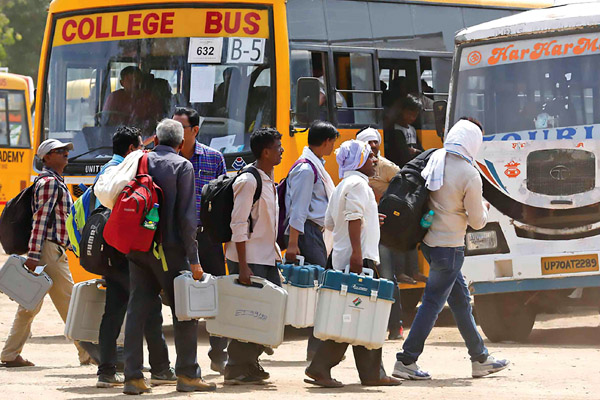
His most glaring example of his unseeing-the-seen was his handling of the NaMo TV issue. “It was a blatant violation of all established norms and guidelines for launching a TV channel. That too, bang in the middle of the election campaign when the Model Code of Conduct was in force. Yet the EC decided to soft-peddle on the issue,” said Prem Swarup Nayyar, veteran Congress leader.
On March 31, almost two weeks after the MCC came into force, NaMo TV mysteriously appeared on all cable and DTH platforms. There was never a shadow of doubt about the channels purpose or intent: that is to provide wall-to-wall coverage of Narendra Modi’s election speeches and campaign. It was simply a grand propaganda vehicle of the ruling BJP using the national airwaves.
Unlike other television channels that are by bound Cable Television Network Rules, 1994, and are listed under Ministry of Information and Broad-casting’s Policy Guidelines for up-linking of television channels, there was no information available about NaMo TV’s broadcast licence, ownership, nature of content, uplinking and downlinking permission, foreign partners, home ministry’s security clearance, etc. In short, it was allegedly a ghost channel that suddenly appeared on broadcasting platforms. Prima facie, NaMo TV was reportedly operating in gross violation of a host of laws of
the land.

It was only after the opposition raised a massive hue and cry about NaMo TV queering the campaign pitch that the EC decided to act reluctantly. It chose to throw the ball in court of the Ministry of Information and Broadcasting (MIB) under Rajyavardhan Singh Rathore to provide details of the channel. The MIB very ingeniously and conveniently categorised it as an “advertising platform” like Home Shopping, which exempted it from licensing requirements since the content was being transmitted to the DTH or cable distributor over optic fibre. Even then, NaMo TV violated a 2014 order of Telecom Regulatory Authority of India which permits transmission of such content to only “one platform.”
Despite multiple violations of regulations, what did the EC do? It simply asked the BJP, which reportedly funded NaMo TV, to get its content approved before it was put on air. It was not even a proverbial slap on the wrist and NaMo TV merrily continued with political messaging during the entire period of the Model Code of Conduct (MCC) in operation.
Under Arora the commission’s credibility as an independent constitutional authority continued to take body blows throughout the campaign period. It took no less than the Supreme Court to step in to push the commission to convene meetings just to look into the complaints of alleged MCC violations committed by Modi and BJP president Amit Shah. On April 15 the EC pleaded in the SC that it was “powerless” to stop hate speeches and communal propaganda, prompting the apex court to issue a sharp rebuke. Magically, that same evening the EC recovered its lost power and barred Yogi Adityanath and Mayawati from campaigning for 48 and 72 hours, respectively, for delivering communal speeches. The next day, the Chief Justice of India, Justice Ranjan Gogoi remarked, “Seems you have got your powers now”.
It’s a recorded fact that the EC sat on the complaints against Modi and Shah for alleged violations of the MCC for 25 days before convening a meeting to dispose them only after the complainants approached the SC. Some of these complaints pertained to the repeated references to the Balakot air strikes to score political brownie points with the electorate, despite the EC’s direction to avoid references to the armed forces on the campaign trail. Yet, a number of BJP candidates, including Shah, kept referring to the operations carried out by the Indian Air Force as action by Modi ji kivayusena (Modi’s air force).
“With deep anguish we are drawing your attention to the latest violation of Model Code of Conduct (MCC) by Prime Minister Narendra Modi. He is also violating the specific direction of the Election Commission to refrain from invoking the armed forces for seeking votes,” CPI-M politburo member NilotpalBasu said in the letter to the EC.
Former J&K Chief Minister Omar Abdullah too expressed his anguish at Modi’s attempt to garner votes in the name of Balakot strikes. “I hope the first-time voters ask PM Modi why Balakot became necessary in the first place. Why did the Pulwama attack succeed? On whose watch have attacks in Uri, Pathankot, Sunjwan (Jammu), Nagrota and Pulwama happened? Don’t reward Balakot, punish Pulwama!” tweeted Abdullah.
It was subsequently revealed that there was significant disquiet within the commission about the way these complaints were handled when Election Commissioner Ashok Lavasa sought to recuse from meetings for poll code violation. Lavasa later pointed out in an interview to a newspaper that he wanted a time-bound disposal of all MCC complaints. “I have no axe to grind. My concern is to have a system of disposal of Model Code of Conduct (MCC) violation cases in a time bound, transparent, and non-discriminatory manner,” Lavasa told Hindustan Times. Lavasa also wanted dissenting notes to be recorded and be made part of the decisions taken by the three-member body.
Among the clean chits that were given to Modi was one for his election speech where he referred to Wayanad, from where Rahul Gandhi was contesting in a second seat besides Amethi, as a place where the majority population of the country was in minority. Modi’s claim was not only patently false, it was also communally polarising and deeply troubling, especially coming from the Prime Minister of the country. According to the Census 2011 data, the total population of Wayanad comprises 49.48 percent Hindus, 28.65 percent Muslims and 21.34 percent Christians.
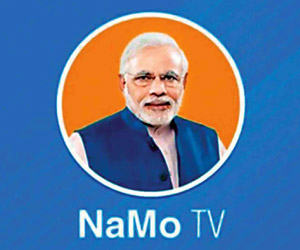
The litany of Arora’s allegedly questionable conduct is long. After the final phase of the election was over on May 19, multiple video clips surfaced on social media showing questionable and mysterious transportation of EVMs, including some of them in private vehicles without any official accompanying them. The videos showed that the transportation of the machines was done by contracted labour in the most casual manner.
As the chatter on social media grew louder, the EC issued a statement that the video clips pertain to the movement of reserve or unused EVMs. “The aspersions in clips being used in media merely pertain to the storage or movement of reserve unused EVMs. However, any case of lapse even in handling of reserve EVMs is thoroughly investigated and disciplinary action taken against the officers responsible,” said the statement.
It took no less than the Supreme Court to step in to push the commission to convene meetings just to look into the complaints of alleged MCC violations committed by Modi and BJP president Amit Shah
The commission’s official line stood at serious variance of its own notification issued on February 7, 2019, regarding transportation of voting machines. Point five of notification No. 51/8/3/2019-EMPS reads: “Adequate foolproof security arrangements ensuring the integrity of EVMs/VVPATs would be made for the transportation of the machines and the movement of each of the vehicles carrying EVMs/VVPATs should be closely monitored on daily basis until it reaches the destination with the help of Chief Electoral Officers/ District Election Officers of the concerned States through which the vehicle carrying EVMs/ VVPATs are to pass. Every vehicle carrying EVMs/ VVPATs shall be fitted with GPS. One official with each vehicle should be also appointed by the CEO/ DEO….”
Even as gfiles goes to press, several reports have surfaced how the voter turnout data doesn’t tally with the votes counted in the EVMs in a large number of constituencies, raising serious concerns about the sanctity of the entire voting process in these elections. Once these reports started appearing in the public domain, the EC’s first reaction was to pull down some of the data from its website and then claimed that it was provisional data as the final figures are still being tabulated.
The BJP might have returned to power with brutal majority, sweeping away the entire opposition, but CEC’s role and conduct in the 2019 General Election has left serious dents to the credibility of the Election Commission of India. It’s a pale shadow of the days when men like TN Seshan and JM Lyngdoh made the EC a much-feared institution that put the politicians in their place.
Journalist | Editor | Allahabadi

















































